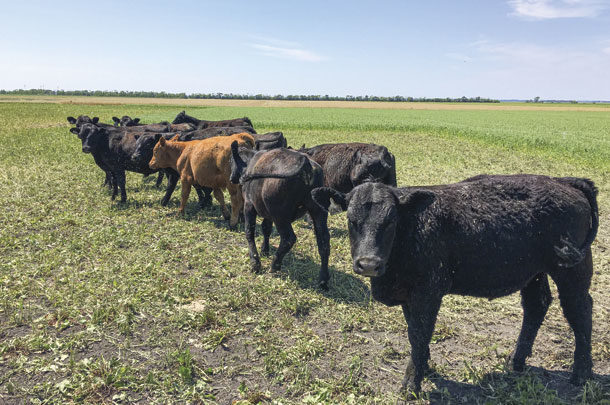This increase in cover crop acreage provides an opportunity for ranchers.
Cover crops are a great way for ranchers to add flexibility into their grazing system. Planting cover crops will produce a high-quality forage and extend the grazing season while allowing rangeland and pastures adequate time to recover.
However, grazing cover crops can present some unique challenges to ranchers. Here are four things to keep in mind as you prepare to graze cover crops this fall.
1. Know the quality of your forage
I cannot overstress the importance of knowing the quality of the feed you are feeding your cattle so you can ensure you are meeting their nutritional requirements. This is especially important when grazing cover crops because the quality will vary depending on the species, varieties and maturity. Forage quality parameters to be most concerned with include crude protein, digestibility and fiber level as well as minerals.
Brassicas such as turnips and radish often are incorporated into cover crop mixes as a high-quality forage. Research on species and variety of brassicas conducted at North Dakota State University reported crude proteins of 14% to 27% and total digestible nutrients (TDN) of 70% to 80%. In addition, they can contain as much as 80% water, depending on timing of grazing.
This combination can disrupt rumen function if high-fiber plants such as millet, sorghum, sudangrass and corn are not included in the mix. Ranchers may need to provide low-quality supplemental fiber, such as low-quality hay or straw, to increase intake and maintain performance.
2. Be aware of potential toxins
Many species of cover crops have the potential to be toxic to cattle. Producers must be aware of potentially toxic species, conditions that increase the risk of toxicity and grazing management practices that reduce the potential of cattle consuming toxic forage. The most common toxicities associated with cover crops include hydrocyanic acid (HCN), nitrate and sulfur.
Hydrocyanic acid (HCN)
Forage sorghum, sudangrass and hybrids contain HCN in the leaves and stems. The concentration of HCN depends on the species, variety, maturity, plant injury and environmental damage (hail and frost). The concentrations of HCN decrease as the plant matures. Damage or injury to the plant from hail, insects, frost or harvest breaks cells and releases the toxins.
These grazing management strategies reduce the potential for HCN toxicity:
- Delay grazing cattle until forage is 18 to 24 inches tall.
- Avoid grazing regrowth under 12 inches.
- Do not graze following hail or a light frost. Grazing after a killing frost is safe because the HCN dissipates quickly after the plant dies.
Nitrates
Nitrates can accumulate in small-grain forages (wheat, oats, rye, triticale and barley), sorghum, sudangrass and corn. When plants encounter stressful growing conditions, photosynthesis is inhibited and the potential for accumulation of nitrates is increased. We typically associate nitrate accumulation with drought stress, but it also can accumulate during prolonged periods of cool, cloudy weather.
These strategies can help reduce the risk of nitrate poisoning when grazing:
- Do not move hungry cows.
- Provide cattle roughage to reduce the amount of nitrate ingested.
- Do not overstock pastures when grazing high-nitrate forages. Overstocking increases the amount of high-nitrate plant parts (stems and stalks) consumed by cows.
3. Know your carrying capacity
One of the most frequent cover crop-related questions I get from cattleman is, “What is the stocking rate?” The stocking rate is going to depend on the carry capacity of the cover crop and individual management goals.
A number of factors influence carrying capacity, including soils, type of cover crop, stage of growth and rainfall. To determine carrying capacity accurately, one first must determine forage production of the area to be grazed.
The most accurate method to calculate forage production is the clip-and-weigh method. This method requires the actual harvesting of standing forage at a given time to predict available forage. The available forage is measured by hand clipping and weighing a specified number of plots within a grazing/forage production area. See NDSU Extension publication “NDSU Range and Forage Production Sample Kits” (R1838) for detailed instructions on calculating forage production.
Once forage production has been determined, then an adjustment must be made for harvest efficiency. Harvest efficiency is the amount of the plant livestock will impact during the time they are grazing the pasture. Harvest efficiency is expressed as a percent and should be multiplied by the total amount of forage on your pasture to give you the amount of forage available for grazing animals.
When grazing cover crops, your harvest efficiency will depend on the desired amount of residue following grazing. The two most common scenarios are “take all, no residue left behind,” 75% harvest efficiency; and “take half, leave half,” 35% harvest efficiency.
4. Design considerations to optimize grazing efficiency
One common complaint from those grazing cover crops is forage waste. Forage waste can be reduced and harvest efficiency increased by dividing the field into cells based on stocking rate. Limiting the area cattle can access reduces feed waste and improves nutrient distribution. The most effective way to do this is with temporary fencing. Fences can be set up prior to grazing or prior to moving cattle into the next cell.
As you establish your grazing cells, be sure to consider access to water. This may limit the design of your grazing system because many fields do not have developed water sources. The most effective design is to start grazing in the cell nearest the water sources and work away from them, allowing cattle to come back across the grazed cells to access water.
Integrating cover crops into your grazing system has the potential to enhance cattle and crop production when done properly. Keep these keys in mind as you begin grazing cover crops this fall. ![]()
PHOTO: Grazing cover crops can add flexibility to a grazing system, providing high-quality forage and an opportunity to extend the grazing season. Photo courtesy of NDSU Extension.

-
Miranda Meehan
- Livestock Environmental Stewardship Specialist
- North Dakota State University
- Email Miranda Meehan







